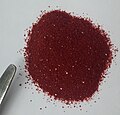Metal dithiolene complex
Metal dithiolene complexes are a class of coordination compounds consisting of a metal center coordinated to dithiolene ligands. Dithiolene ligands are organic compounds containing a sulfur atom bonded to a carbon atom, which is in turn bonded to another sulfur atom, forming a C2S2 ring. These complexes are notable for their diverse range of electronic structures, which can be tuned by varying the metal center or the substituents on the dithiolene ligand. This versatility makes metal dithiolene complexes interesting for applications in catalysis, molecular electronics, and as models for biological systems.
Structure and Bonding
Metal dithiolene complexes typically exhibit a square planar geometry around the metal center, which can be attributed to the strong σ-donation and π-backbonding between the metal and the dithiolene ligand. The dithiolene ligand acts as a 2-electron donor through its sulfur atoms, and the delocalized π-system over the C2S2 ring allows for efficient overlap with the metal d orbitals. This bonding interaction stabilizes low oxidation states of the metal, leading to complexes with unique electronic properties.
Synthesis
The synthesis of metal dithiolene complexes generally involves the reaction of a metal precursor with a dithiolene ligand precursor. A common method is the reaction of a metal salt with a dithione, which is then deprotonated to form the dithiolene ligand. Alternatively, preformed dithiolene ligands can be directly reacted with metal sources under appropriate conditions. The choice of solvent, temperature, and reaction time can significantly affect the yield and purity of the resulting complex.
Applications
Metal dithiolene complexes have found applications in various fields due to their unique properties. In catalysis, they are used as catalysts for reactions involving electron transfer, such as the reduction of carbon dioxide. In molecular electronics, their ability to undergo reversible redox reactions makes them suitable for use in molecular switches and transistors. Furthermore, the structural similarity of some metal dithiolene complexes to the active sites of certain enzymes has made them valuable models for studying enzyme mechanisms.
Biological Relevance
Certain metal dithiolene complexes are analogs of the active sites in enzymes such as xanthine oxidase and sulfite oxidase. These enzymes play crucial roles in the metabolism of nucleotides and sulfur-containing amino acids, respectively. Studying metal dithiolene complexes provides insights into the electronic structure and reactivity of these enzyme active sites, contributing to our understanding of their function in biological systems.
See Also
Metal_dithiolene_complex
Transform your life with W8MD's budget GLP-1 injections from $125.
W8MD offers a medical weight loss program to lose weight in Philadelphia. Our physician-supervised medical weight loss provides:
- Most insurances accepted or discounted self-pay rates. We will obtain insurance prior authorizations if needed.
- Generic GLP1 weight loss injections from $125 for the starting dose.
- Also offer prescription weight loss medications including Phentermine, Qsymia, Diethylpropion, Contrave etc.
NYC weight loss doctor appointments
Start your NYC weight loss journey today at our NYC medical weight loss and Philadelphia medical weight loss clinics.
- Call 718-946-5500 to lose weight in NYC or for medical weight loss in Philadelphia 215-676-2334.
- Tags:NYC medical weight loss, Philadelphia lose weight Zepbound NYC, Budget GLP1 weight loss injections, Wegovy Philadelphia, Wegovy NYC, Philadelphia medical weight loss, Brookly weight loss and Wegovy NYC
|
WikiMD's Wellness Encyclopedia |
| Let Food Be Thy Medicine Medicine Thy Food - Hippocrates |
Medical Disclaimer: WikiMD is not a substitute for professional medical advice. The information on WikiMD is provided as an information resource only, may be incorrect, outdated or misleading, and is not to be used or relied on for any diagnostic or treatment purposes. Please consult your health care provider before making any healthcare decisions or for guidance about a specific medical condition. WikiMD expressly disclaims responsibility, and shall have no liability, for any damages, loss, injury, or liability whatsoever suffered as a result of your reliance on the information contained in this site. By visiting this site you agree to the foregoing terms and conditions, which may from time to time be changed or supplemented by WikiMD. If you do not agree to the foregoing terms and conditions, you should not enter or use this site. See full disclaimer.
Credits:Most images are courtesy of Wikimedia commons, and templates, categories Wikipedia, licensed under CC BY SA or similar.
Contributors: Prab R. Tumpati, MD



